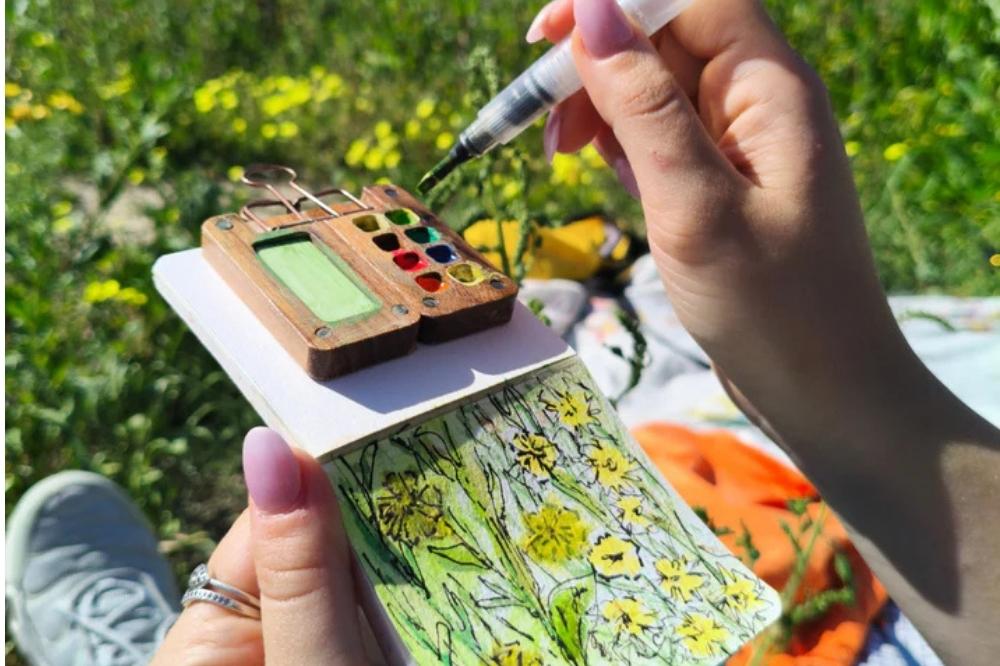Quick Answer (Kid vs Adult Kits at a Glance)
Shopping for watercolor kits can be confusing when faced with dozens of options. Here’s what separates kids’ sets from adult versions:
- Safety compliance: Kids’ kits meet strict non-toxic standards (ASTM D-4236) with washable dyes
- Pigment load: Adult sets contain 3-4x more pigment for richer colors
- Washability: Kids’ paints wash out easily; adult pigments may stain
- Brush quality: Children’s brushes prioritize durability over precision
Quick Cheat Sheet:
- Toddlers (3-5): Washable, large pans, chunky brushes
- School-age (6-9): Non-toxic, spill-proof palettes, synthetic brushes
- Teens (10-17): Student-grade pigments, better paper, detail brushes
- Adults: Higher pigment concentration, quality brushes, cotton paper

Safety First (What Parents and Teachers Should Know)
Labels & Standards
Kids’ watercolor kits must display non-toxic labeling (ASTM D-4236 in the US, EN-71 in Europe). These sets exclude heavy metals and use food-grade dyes. Watch for choking hazard warnings on small parts like brush caps or tiny paint pans for children under three.
Washability & Cleanup
Children’s watercolors use washable dyes that come out with soap and water. Adult pigments, especially cadmium-based reds and phthalo blues, can permanently stain fabrics and surfaces. For classroom use, protect tables with plastic sheets and have kids wear smocks—even “washable” paints can leave traces on delicate fabrics.
Pigmentation & Paper (Why Adult Sets Look Different)
Student vs Artist Grade
The main difference lies in pigment concentration. Kids’ paints contain 15-20% pigment mixed with fillers and binders, creating lighter, less saturated colors. Adult student-grade sets have 30-40% pigment, while professional artist-grade paints contain 40-80% pure pigment. This affects color intensity, mixing ability, and lightfastness—how well colors resist fading over time.
Paper Matters
Kids work best with 200-300gsm cellulose paper that resists buckling from heavy water use. Adults benefit from cotton or cotton-blend paper (300gsm minimum) that allows for advanced techniques like wet-on-wet blending and glazing without pilling or warping.
Brush Durability & Control
Kids’ brushes feature synthetic bristles with crimped ferrules (the metal part) that won’t loosen with rough handling. The handles are often plastic or thick wood to prevent breakage. Adult brushes prioritize “snap” (spring-back ability) and point retention for detailed work. Natural hair or high-quality synthetic blends allow for better water control and smoother washes.
Water brushes—those with built-in reservoirs—work well for both groups. They’re spill-proof for classrooms and portable for adult sketchers, though flow control takes practice.
What’s in the Box? Typical Kit Contents
Kids’ Kits Usually Include:
- 8-24 pan colors (often with fun metallics or neons)
- 1-2 basic brushes
- Plastic mixing palette
- Sometimes: sponges, stamps, or activity books
Adult Kits Typically Contain:
- 12-48 colors in pans or tubes
- 2-4 varied brush sizes
- Folding metal or plastic palette
- Often: masking fluid, pencil, or travel case
Buyer’s Guide: Age-Based Recommendations
| Age Range | Best Kit Type | Key Features | Price Range |
| 3-5 years | Washable pan set | Large pans, spill-proof palette, chunky brushes | $10-20 |
| 6-9 years | Non-toxic student set | 12-18 colors, synthetic brushes, mixing tray | $15-30 |
| 10-13 years | Student-grade kit | Better pigmentation, detail brush included | $25-40 |
| 14+ & Adults | Student to artist-grade | High pigment load, quality brushes, travel case | $30-100+ |
When to Upgrade from a Kids’ Set
Consider upgrading when you notice:
- Colors looking muddy or chalky when mixed
- Frustration with achieving vibrant colors
- Paper constantly buckling or pilling
- Interest in learning proper watercolor techniques
A budget upgrade path: Start with a student-grade adult kit ($30-40), add quality watercolor paper ($15-20), and invest in two good brushes—a round #6 and a detail #2 ($20-30 total).
Example Setups
Kids’ Classroom Setup: 12-pan washable set + 200gsm paper pad + 2 synthetic rounds + spill-proof water cup ($25-35 total)
Adult Beginner: 12-pan student-grade set + 300gsm cotton-blend pad + round and flat brush + portable palette ($50-70 total)
For compact, travel-friendly options perfect for beginners or gifts, explore sets at Tobios Kits which offers portable palettes ideal for urban sketching.
FAQs
Are watercolor kits safe for toddlers? Yes, if labeled non-toxic (ASTM D-4236). Supervise use and choose sets without small parts for children under three.
What makes adult watercolors harder to wash out? Higher pigment concentration and professional-grade binders designed for permanence make adult paints more likely to stain.
Do I need cotton paper as a beginner? Not immediately. Start with cotton-blend paper (25% cotton) to learn techniques without the higher cost of 100% cotton.
How many colors does a kid really need? 8-12 colors are plenty. Kids learn color theory better with a limited palette plus the three primaries for mixing.
The Bottom Line
Choose kids’ watercolor kits for safety, washability, and durability. Opt for adult sets when color quality, permanence, and technique development become priorities. Most importantly, match the kit to the user’s age, skill level, and artistic goals rather than buying based on price alone. The right tools make all the difference in fostering a love for watercolor painting at any age.

